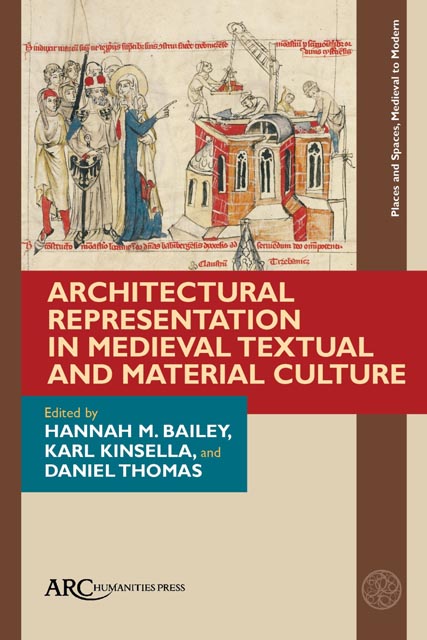Book contents
- Frontmatter
- Contents
- List of Illustrations
- Acknowledgements
- Introduction: Architectural Representation in Medieval Textual and Material Culture
- Chapter 1 Designing the Regensburg Spire and Harburg Tabernacle: The Geometries of Two Great German Gothic Drawings
- Chapter 2 Wilfrid’s Restoration of the Church at York and the Permanence of Sacred Buildings in Post-Conversion Northumbria
- Chapter 3 Heaven-Roofs and Holy Altars: Envisioning a Seventh-Century English Church in Aldhelm’s Carmina Ecclesiastica 3
- Chapter 4 “Beaten Down and Built Anew”: Saint Erkenwald and Old St. Paul’s
- Chapter 5 Castle Viewscapes in Literature and Landscapes
- Chapter 6 Architectural Alignment in Early Medieval English Settlements: Zoning, Meaning, and Function
- Chapter 7 Underneath the Arches: Peter of Eboli and the Orderly Architecture of Norman Sicily
- Chapter 8 Reading the Saint’s Church: A Northern Perspective
- Select Bibliography
- Index
Chapter 4 - “Beaten Down and Built Anew”: Saint Erkenwald and Old St. Paul’s
Published online by Cambridge University Press: 16 November 2023
- Frontmatter
- Contents
- List of Illustrations
- Acknowledgements
- Introduction: Architectural Representation in Medieval Textual and Material Culture
- Chapter 1 Designing the Regensburg Spire and Harburg Tabernacle: The Geometries of Two Great German Gothic Drawings
- Chapter 2 Wilfrid’s Restoration of the Church at York and the Permanence of Sacred Buildings in Post-Conversion Northumbria
- Chapter 3 Heaven-Roofs and Holy Altars: Envisioning a Seventh-Century English Church in Aldhelm’s Carmina Ecclesiastica 3
- Chapter 4 “Beaten Down and Built Anew”: Saint Erkenwald and Old St. Paul’s
- Chapter 5 Castle Viewscapes in Literature and Landscapes
- Chapter 6 Architectural Alignment in Early Medieval English Settlements: Zoning, Meaning, and Function
- Chapter 7 Underneath the Arches: Peter of Eboli and the Orderly Architecture of Norman Sicily
- Chapter 8 Reading the Saint’s Church: A Northern Perspective
- Select Bibliography
- Index
Summary
The late fourteenth-century poem Saint Erkenwald opens with the construction of St. Paul's Cathedral on the site of a pagan temple which is “beten doun and buggyd efte new” (“beaten down and built anew,” l. 37). The poet demonstrates a keen sense of the place that St. Paul's has, for centuries, occupied in the cultural imagination of “London in Englonde” (“London in England,” l. 1). Then, as now, the monumental structure occupying the site was a symbol of continuity and endurance; at the same time, the evolving form of the building—destroyed and rebuilt several times over the centuries—charts the tumultuous history of the city and celebrates the resilience and adaptability of its people. The Gothic cathedral that dominated the medieval skyline was destroyed by the Great Fire of 1666, posing a challenge for modern readers who seek to imagine the space of St. Paul's as it was understood when Saint Erkenwald was written. Compounding this difficulty, some influential studies have tended to erase Old St. Paul's from the poem by arguing that the poet's true interests lie with events and debates that centred on other sacred spaces, such as Westminster Abbey. The setting in Old St. Paul’s, however, is much more than a backdrop to the action. By mapping the events of the poem onto what we know of the building as it stood in the late fourteenth century, we can come to understand that, as both a monument to eternity and a chronicle of the turbulent history of church and state, Old St. Paul's provides an essential foundation for the poem's argument. By excavating the literary traces of the now-lost cathedral, we can start to recover the history of medieval buildings that have been erased or substantially altered over time, and better understand how those spaces were read and interpreted at earlier historical moments.
The action of Saint Erkenwald unfolds, with striking specificity, within the grounds of St. Paul's Cathedral. After a brief historical prelude, which traces the history of Britain with a particular focus on the arrival of the “Saxones unsaght” (“hostile Saxons,” l. 8) and the mission of St. Augustine, the poem launches into a description of a great pagan temple that is demolished and rebuilt, as part of a program to convert pagan places of worship into churches (in this case, St. Paul’s).
- Type
- Chapter
- Information
- Publisher: Amsterdam University PressPrint publication year: 2023



